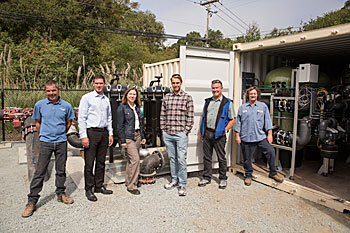By Kim Adamson, General Manager for Soquel Creek Water District

As I may have said in a past column or community presentation I’ve given – water on this planet is used and re-used. Throughout the US and abroad, one city’s river source of drinking water is another city’s discharge of wastewater upstream. One community’s groundwater system isn’t just made of the rain that’s fallen. It includes the minerals and contaminants that are either naturally occurring underground or contaminated by man. Chemicals and pollution to our oceans, rivers, and watersheds are challenges that water agencies face and there are strict guidelines and regulations in place by the state and federal government to monitor, measure, and ensure that high quality water is produced.
This month I want to focus on water quality and recent issues that we’re working on in the Mid-County region.
In July 2014, California tightened the Chromium 6 standard to a maximum of 10 parts per billion (ppb). The District board set our local goal to be one-fifth of the State’s requirement (2 ppb) for our water supply and we’re aiming to meet that. The pilot treatment system is located at the San Andreas well site near Hwy 1 and San Andreas Road. The facility showcases an innovative ion exchange technology that the District evaluated after being awarded grant funding by the Water Research Foundation in 2013. It’s the first time this technology has been used in the US, and the pilot results have been extremely impressive. The current facility is temporary until the District constructs a larger, permanent facility that will be operational by October 2016.
Seawater Intrusion Monitoring: The District maintains and monthly measures groundwater levels and water quality samples from over 70 monitoring wells. Neighboring agencies such as Pajaro Valley Water Management Agency and the City of Santa Cruz also conduct monitoring.
Emerging Constituents: Some of our customers have recently shared concerns they have about emerging constituents (ECs), which are chemicals discovered in water that were not previously detected or are being detected at new levels. Examples of these are prescription drugs, personal care products, food additives and common household chemicals that enter our water supply when they go down the drain or get flushed in our homes.
Emerging constituents may be found in all sources of water — including surface water (like streams), groundwater basins, ocean water and wastewater. Federal and state authorities have not yet established an official water quality standard, approved a standard analytical method, or required routine monitoring and reporting. The California Office of Environmental Health Hazard Assessment and the US Environmental Protection Agency have primary legal responsibility for making the necessary risk assessments and recommending appropriate water quality standards for all chemicals including ECs.
•••
For more information on water quality, please visit our website at www.soquelcreekwater.org/water-quality or contact me at 831-475-8500 or kima@soquelcreekwater.org. The District strives to provide safe, reliable, high-quality drinking water to our customers and the mid-county community.